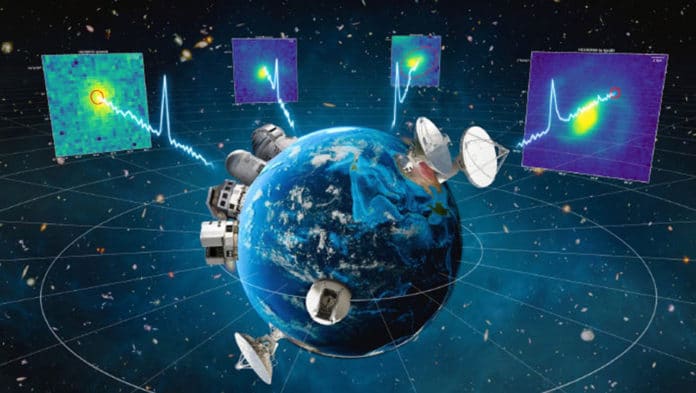Fast Radio Bursts are very mysterious bursts of radio waves, coming from all over the sky. In just a millisecond, a single burst releases more energy than our Sun emits in 80 years.
Although the exact origin and cause are uncertain, most are believed to be extragalactic.
Now, an international team of astronomers led by Shivani Bhandari, an astronomer with CSIRO, Australia’s national science agency, has made a crucial breakthrough by zooming in on the precise location of four fast radio bursts and having a look around their ‘neighborhoods.’
The discovery was made possible by using a specially designed transient detector on CSIRO’s ASKAP radio telescope in outback Western Australia. Astronomers found that these fast radio bursts came from the outskirts of their home galaxies.
Bhandari, an astronomer with CSIRO, Australia’s national science agency, said, “This first detailed study of the galaxies that host fast radio bursts rules out several of the more extreme theories put forward to explain their origins, getting us closer to knowing their true nature.”
Co-author CSIRO’s Professor Elaine Sadler said these fast radio bursts could not have come from a superluminous stellar explosion or cosmic strings.
“Models such as mergers of compact objects like white dwarfs or neutron stars, or flares from magnetars created by such mergers, are still looking good.”
Astronomers then conducted follow-up observations using Keck Observatory’s Keck Cosmic Web Imager (KCWI) in collaboration with Gemini South, ESO’s Very Large Telescope, Magellan Baade, and LCOGT-1m.
Investigating if fast radio bursts favor a certain type of galaxy, the team found all four bursts came from massive galaxies that are forming new stars at a modest rate.
Dame Jocelyn Bell Burnell said, “Positioning the sources of fast radio bursts is a huge technical achievement and moves the field on enormously. We may not yet be clear exactly what is going on, but now, at last, options are being ruled out. This is a highly significant paper, thoroughly researched, and well written.”
Dame Jocelyn Bell Burnell, who as a postgraduate student in 1967, was the first to detect rapidly spinning neutron stars now known as ‘pulsars.’
Journal Reference:
- Shivani Bhandari, The Host Galaxies and Progenitors of Fast Radio Bursts Localized with the Australian Square Kilometre Array Pathfinder. DOI: 10.3847/2041-8213/ab672e
